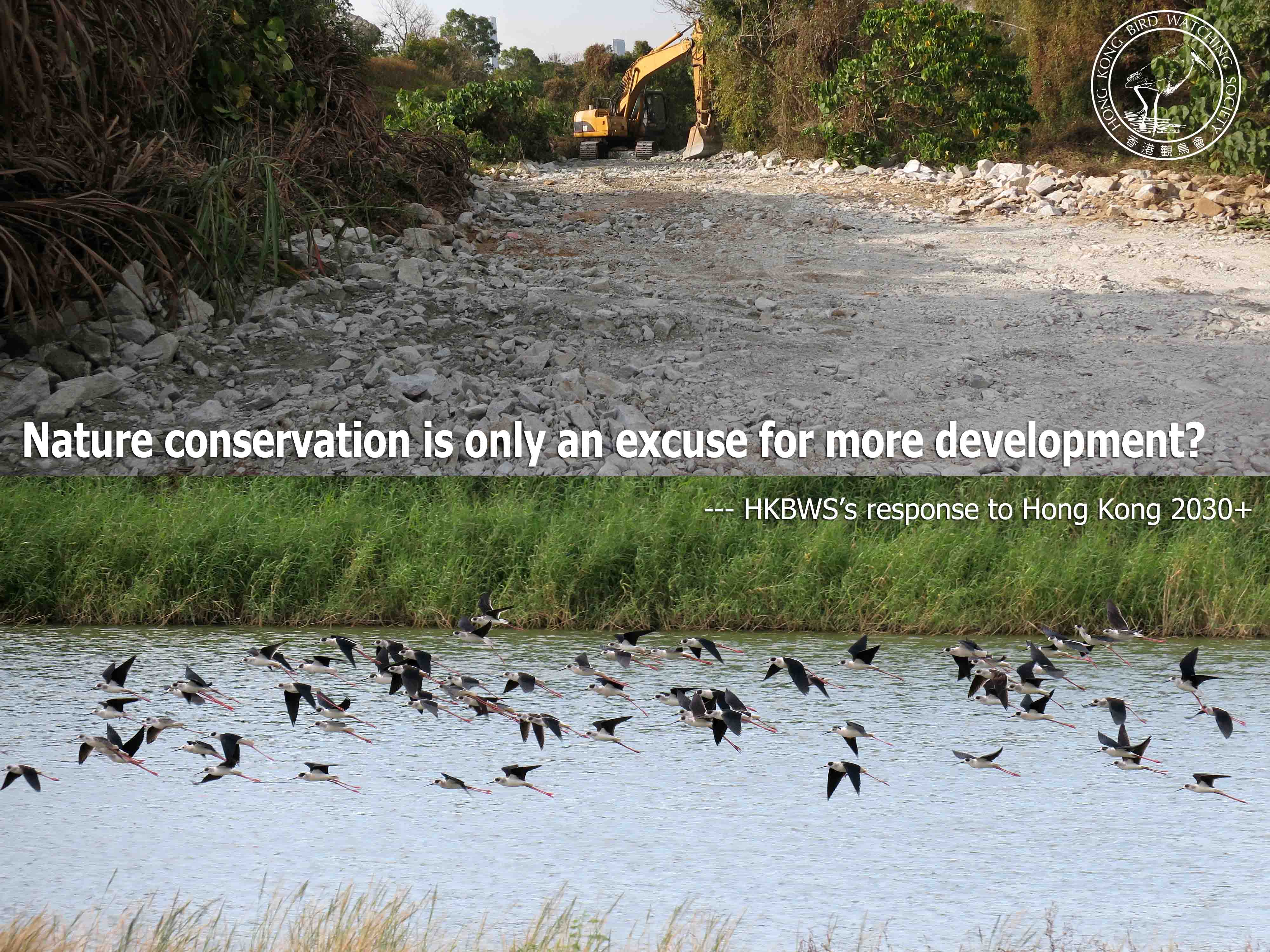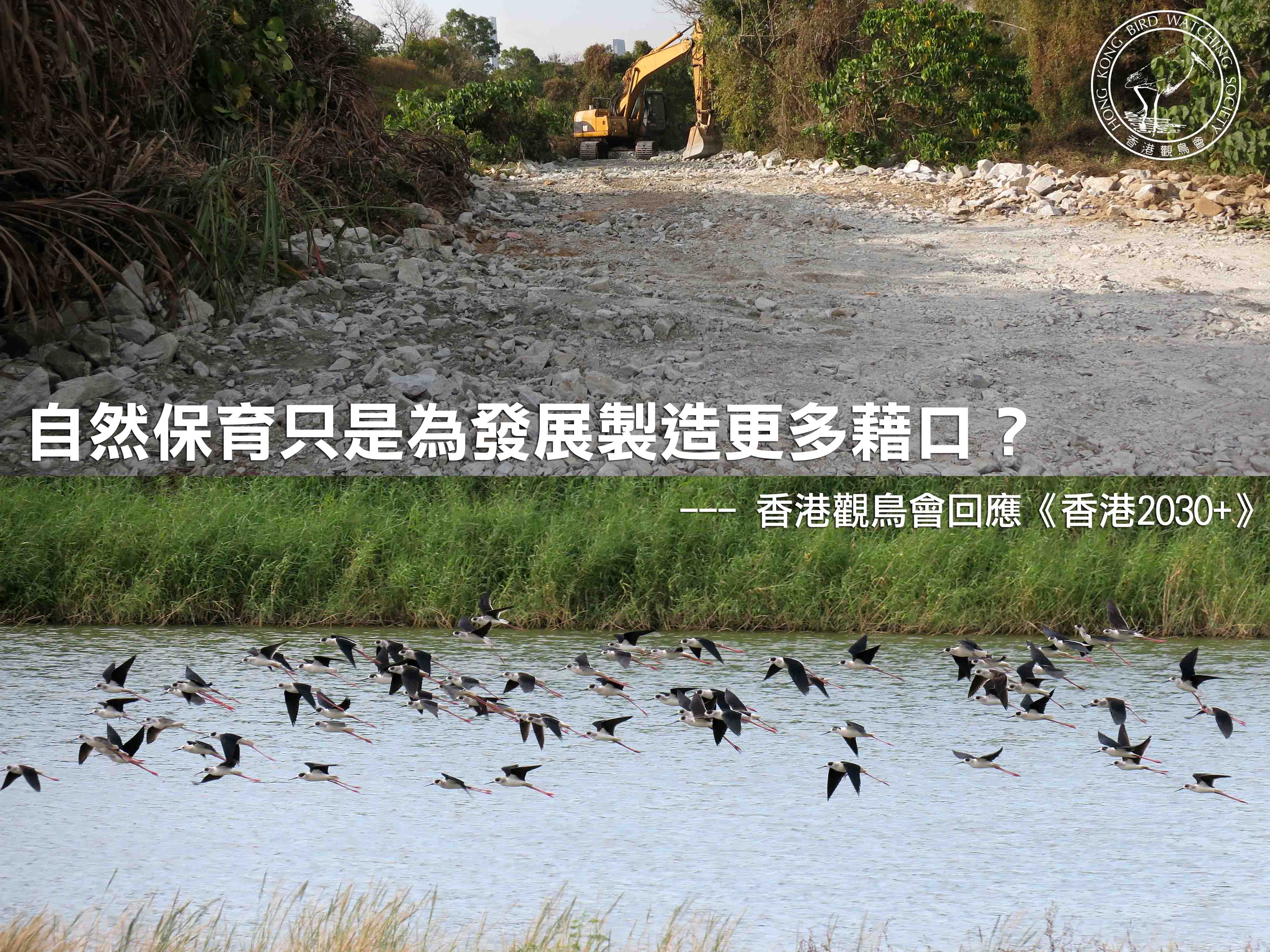
 Nature conservation is only an excuse for more development?
Nature conservation is only an excuse for more development?
HKBWS’s response to Hong Kong 2030+
The Hong Kong Bird Watching Society (HKBWS) agrees with the need for a strategic planning and supports environmentally sustainable development. However, Hong Kong 2030+ did not equally considers the environmental, social and economic needs of Hong Kong for a truly sustainable development of the city. The proposed strategic planning is still heavily development and economy driven with a lack of commitment in nature conservation, as it is now. Even though terms like “sustainable” and “green” were frequently mentioned in the consultation document, the proposed developments and conservation actions seems far from what these terms actually mean. There is a lack of measures designed with the primary and specific intent of protecting Hong Kong’s biodiversity and quality of life, no changes in the currently flawed system which allows ongoing ecological destruction of habitats, no recognition and protection of buffer zones, and no comprehensive policies to allow conservation and agriculture to be sustainable.
Moreover, we consider that the Government has simplified various social issues in Hong Kong, claiming that the main reason is the shortage of land supply. Apart from unaffordable housing, there are other social issues, such as disparity between the rich and the poor, environmental pollution, distrust of the government, injustice in the current system, which has torn our society into pieces. Without identifying and facing the real causes of all these social issues, problems would not be solved; but instead would intensify the unnecessary dilemma between social needs and nature conservation, damaging both the public interest and the natural environment. The sustainable and green vision that the Government has for 2030 and beyond would not be reached.
The HKBWS considers that the Hong Kong 2030+ is a golden opportunity for Hong Kong to restore the harmony within the society and to integrate environmental and ecological sustainability into the city’s long-term planning and development process in order to tackle the on-going social and environmental problems that we have been facing. Below is a summary of our comments on the consultation document, primarily focusing on the conservation and protection of Hong Kong’s natural assets.
1. Conservation measures are not purely for conservation
Nature conservation is not only important to our environment, but it is also vital for better health and well-being, increase in quality of life and thus generating economic benefits. Although there are areas of well-recognized conservation importance, the long-awaited designation of country/marine parks only occurred when there is a development need (e.g. it is suspected that the designation of Southwest Lantau Marine Park and the Sokos Island Marine Park is to make way for the Hong Kong Airport Three Runway System). Some conservation measures are in fact mitigation measures of development projects (e.g. Brothers Marine Park is related to the Hong Kong-Zhuhai-Macau Bridge development). We are concerned the so-called “environmental capacity” created would only be an excuse for more development elsewhere.
2. Lack of commitments in nature conservation
Protect and enhance our environment requires commitment to nature conservation. However, the proposed development framework failed to avoid ecologically sensitive areas (e.g. reclamation at Lung Kwu Tan affects the habitats of horseshoe crab and Chinese White Dolphins). We consider that biodiversity conservation is still far from full scale integration into Hong Kong 2030+. It is also uncertain if BSAP will expand beyond the first five years and if a nature conservation trust will be set up as part of the long-term conservation measures.
3. Conservation cannot be achieved with currently flawed systems and legislation
Loopholes in existing legislation has allowed the ongoing ecological destruction of natural habitats. We constantly come across no enforcement power from Planning Department for areas without Development Permission Area (DPA), damaged wetland habitats were not reinstated back to original condition, dumping of construction wastes on private wetlands are permitted with the consent of the land owner, and the current Environmental Impact Assessment (EIA) system failed to effectively avoid or minimize adverse impacts. Changes in current policies and legislation is necessary to plug the loopholes for effective protection of Hong Kong’s natural assets.
4. Buffer zones are neglected and their values are not recognized
Buffer zones (e.g. Wetland Buffer Area, Green Belt, Agriculture zones, etc.) may not all of high ecological and conservation value, yet, they have an important role in protecting and enhancing the conservation value of the core areas, i.e. prevent undesirable disturbances and developments, reduce the edge effect. We consider that the Government should not use these buffer zones for development, to avoid today’s conservation areas in becoming tomorrow’s buffer zone.
5. Threats to our agricultural lands
The multiple importance of fallow agricultural land is neglected in the document (including its ecological, landscape, recreation and buffering value) and is not considered as a green asset of Hong Kong. Currently there is an enormous gap is between the land value of agricultural land for development and that for cultivation, which has led to the destruction and loss of arable farmlands. Without a comprehensive policy on agricultural land and loopholes in existing legislations not plugged, we are concerned the proposed “Agricultural Priority Areas” will only initiate more destruction than protection.
6. Generalization of our natural assets to green and blue
Terrestrial, aquatic and marine habitats from urban to countryside are all included in the green-blue assets. However, it is important to distinguish between habitats in urban and in rural areas as they have different ecological sensitivity and management strategies for maximizing their unique functions in the city. We consider that the proposed blue-green strategies are only suitable for enhancement of the urban environment but not for strengthening the protection to our rural and countryside. We are concerned the generalization of our natural assets to green and blue will eventually lead to a loss in our natural environment.
7. Concerns on East Lantau Metropolis (ELM)
We object to the ELM as the large scale reclamation and the transportation connection to Mui Wo would lead to significant adverse ecological impacts to the marine environment and to the unprotected South Lantau Coast. The human activities of such a large population (i.e. 400,000 to 700,000) on ELM will also inevitably lead to undesirable disturbance to the neighbouring islands of conservation concern (e.g. Sunshine Island and Hei Ling Chau). A comprehensive ecological assessment should be conducted before proposing any development projects to assess if the area is suitable for development.
8. Concerns on New Territories North Development (NTN)
The San Tin/Lok Ma Chau development node encroached into Wetland Buffer Area, and together with the proposed Lok Ma Chau Loop development, would further fragment the Deep Bay ecosystem and affect the flightline of birds. The Man Kam To Logistic corridor would intensify urban sprawl and lead to more destruction and disturbance to the adjacent agricultural lands, wetlands and fishponds of conservation concern. As hobby/leisure farms are currently loosely regulated, we are concerned the promotion of Eco/Agro-tourism in NTN would actually lead to more destruction for recreational uses on paved areas and less area for cultivation, thus more arable agricultural land is lost.
9. Unclear consultation timeline and no review mechanism
The timeline for Hong Kong 2030+ seems to indicate that there will be just one stage of public engagement, which cannot generate any meaningful dialogue between the Government and the public, and would lead to high level of public disappointment. The findings of all technical studies and assessment should not be used to polish up the proposed planning framework, but should be provided as the basis of the public engagement discussion. There should be indicators for monitoring and reviewing Hong Kong 2030+ such that the city can be adaptive to future changes and to avoid over-exploitation of natural resources.
*HKBWS's submission on Hong Kong 2030+
**Public Engagement**
Deadline: 30 April, 2017 (Sun)
Consultation document:
http://www.hk2030plus.hk/your_engagement_a.htm
Consultation questionnaire:
http://www.hk2030plus.hk/your_engagement.asp?form=45
Comments can be sent to:
enquiry@hk2030plus.hk

 自然保育只是為發展製造更多藉口?
自然保育只是為發展製造更多藉口?
香港觀鳥會回應《香港2030+》
香港觀鳥會〔下稱「本會」〕認同全港策略性規劃的重要,並支持以可持續發展為原則的發展規劃方向。但《香港2030+:跨越2030年的規劃遠景與策略》〔《香港2030+》〕並沒有充分考慮環境、社會及經濟三方面的需要,建議的策略性規劃其實仍然維持現有的發展模式,即仍以經濟發展為主導,欠缺自然保育方面的承諾。文件雖然經常提及「可持續」及「綠色」等字眼,但建議的發展項目及保育措施距真正的可持續發展仍然很遠。建議的框架缺乏以保護生物多樣性及生活質素為主的措施,不但沒有針對及改善現行的不良制度及法例,甚至默許各樣的環境破壞,沒有充分保護緩衝區及確認其重要性,也沒有整全的政策使保育及農業得以持續。
此外,文件把眾多社會議題都歸咎於土地短缺的問題之上。除了樓價高企,其他譬如貧富懸殊、環境污染、對政府的不信任,以及現行制度的不公平等議題,一直在撕裂本港社會,若不正視這些問題的真正原因,以上一切問題都難以有效解決,反而會加劇社會需求及自然保育之間不必要的對立,損害公眾利益及自然環境,而政府所期望的可持續及綠色願景也無法達成。
本會認為《香港2030+》正好是恢復社會和諧,及將可持續的環境納入社會長遠規劃和發展進程的黃金機會,以解決本港一直存在的社會及環境問題。以下是本會對於諮詢文件就自然保育方面的意見摘要。
1. 保育措施不只是為了保育
自然保育不僅對我們的環境很重要,也為市民的身心健康、生活質素及經濟效益帶來裨益。雖然部分地區的保育價值已被確認,但卻一直延遲到有發展需要才將其納入郊野或海岸公園,例如制訂大嶼山西南海岸公園和索罟群島海岸公園可能只是為興建香港機場第三條跑道開路。一些貎似保育措施,實際卻是發展工程的生態補償,例如大小磨刀海岸公園只是為興建港珠澳大橋工程而制訂。本會擔憂製提出所謂「環境容量」其實只是為發展製造更多藉口。
2. 缺乏對自然保育的承諾
保護及改善我們的環境需要承諾保育我們的自然。但建議的發展框架未能避開生態敏感的地區,譬如龍鼓灘的填海工程會影響馬蹄蟹及中華白海豚的生境,對保育自然欠缺誠意。本會認為生物多樣性的保育仍然沒有完全融入《香港2030+》的策略規劃裡,甚至本港的《生物多樣性策略及行動計劃》會否超越首五年的計劃,或者會否成立自然保育基金作長遠的保育措施,仍然是未知之數。
3.制度及法例的漏洞阻礙自然保育
現存的制度及法律漏洞使自然生境不斷受到破壞。現時經常出現因為沒有發展審批地區圖(DPA)導致規劃署沒有執法權力、受破壞生境未能恢復原狀、業權人合法地允許在其私人濕地上棄置建築廢料,以至現行的環境評估制度無法有效避免或減少對環境的不良影響。為了有效保護香港的天然資源,堵塞現時政策、制度及法例上的漏洞正是急不容緩。
4. 沒有保護緩衝區及確認其價值
不是所有緩衝區都擁有高生態及保育價值,例如后海灣的濕地緩衝區、綠化地帶、農業用地等等,但它們卻在保護及改善核心保育區上扮演重要的角色,即避免不良干擾及發展的入侵,並減少邊緣效應。本會認為政府不應發展緩衝區,以防今日的保護區成為他日的緩衝區。
5. 農地的威脅
文件忽略了休耕農地的多重重要性,包括生態、地貌、康樂及作為緩衝區的價值,也沒有視它為香港的綠色資源。現時,農地的發展價值遠超於農地的耕種價值,導致可耕農地不斷被破壞和減少。沒有整全的農業政策,加上法例的漏洞,恐怕建議的「農業優先區」只會觸發更多破壞多於保護。
6. 將自然資源概括為藍和綠
由市區到郊野的陸地、水生及海洋生境都被統稱為藍綠資源。然而,區分城市及鄉郊的生境是很重要的,因為它們具有不同的生態敏感度及管理策略,以致它們可以在城市不同位置發揮其獨特功能。本會認為文件中提出的藍綠策略只適用於改善市區環境,而並非加強鄉郊地區的保護。本會擔憂將自然資源概括為「藍綠」最終只會導致自然環境的消失。
7. 有關東大嶼都會的問題
大規模填海以及與梅窩的交通連接,將會對海洋生境和不受保護的南大嶼山自然生境造成嚴重的不良影響,因此本會反對東大嶼都會的發展計劃。人工島帶來的龐大人口(約四十萬至七十萬)亦會為鄰近具保育價值的島嶼〔例如周公島及喜靈洲〕帶來不可避免的干擾及不良影響。提出發展計劃之前應先作全面的生態評估,以評核該區是否適合發展。
8. 有關新界北發展的問題
新田/落馬洲發展樞紐入侵了濕地緩衝區,加上鄰近的落馬洲河套區發展,將會進一步割裂后海灣的濕地生境及影響雀鳥的飛行路線。而文錦渡物流走廊將會加劇該區的城市擴張,干擾及損害毗鄰具保育價值的農地、濕地及魚塘。由於現時對休閒農場規管寬鬆,本會擔憂在新界北推廣生態或農業旅遊區,只會令更多農地因此而被破壞,導致可耕農地的不斷萎縮。
9. 沒有清晰的諮詢時間表及檢討機制
文件的諮詢時間表似乎顯示只會有一次的公眾參與階段。本會認為這樣的諮詢,市民和政府並不能作出有意義的對話,亦會令公眾失望。本會認為所有技術研究和評估的結果不應用來裝飾發展規劃的框架,應該讓公眾參閱並作為諮詢及討論的基礎。政府更應設立監督和檢討《香港2030+》的指標,促使城市發展可以因應未來的變化而作出相應的調整,避免過度開發自然資源。
*本會就《香港2030+》的意見書(只提供英文版本)
**公眾諮詢**
截止日期:2017年4月30日
諮詢文件:
http://www.hk2030plus.hk/TC/your_engagement_a.htm
諮詢問卷:
http://www.hk2030plus.hk/tc/your_engagement.asp?form=45
可以將意見電郵至:
enquiry@hk2030plus.hk


